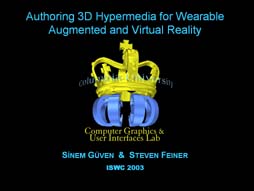Authoring Environments for Mobile Augmented and Virtual Reality |
 |
|
Sinem Güven and Steven Feiner |
Columbia University |
Authoring Environments for Mobile Augmented and Virtual Reality |
 |
|
Sinem Güven and Steven Feiner |
Columbia University |
Using the MARS Authoring Tool, we have created several Situated Documentaries that tell the stories of events that took place on our campus. Users can experience these Situated Documentaries using our experimental wearable MARS backpack. This mobile prototype uses a tracked see-through head-worn display to overlay 3D graphics, imagery, and sound on top of the real world.
© Computer Graphics and User Interfaces Lab, Columbia University
 |
Please send comments to Sinem Güven at <sinem@cs.columbia.edu>